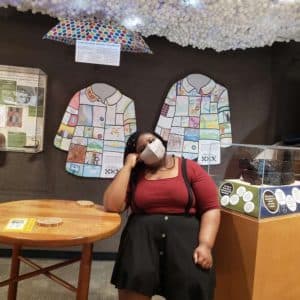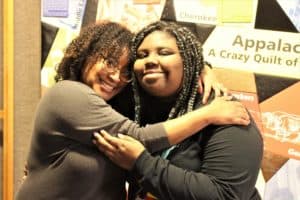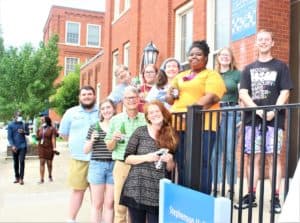Activism as a Queer Black Appalachian in West Virginia
Article written by A-Nya (Thena) Badger



Activism and protesting are a crucial part of what makes up West Virginia’s culture. Most of what I learned about the area was pretty minimized and disconnected from anything I was experiencing on a day-to-day basis. Like any other kid, I wished desperately to fit in, but this included wishing I looked more like the other kids around me. My first challenge to my desire to disappear came when I was around three years old. I went to a protest march with one of my parents. When I became too tired to continue walking, I was carried on their shoulders as I shouted with the crowd, “NO JUSTICE, NO PEACE.” A local restaurant owner offered everyone who protested free wings. I couldn’t tell you who the protest was for or what it was really about, but I knew it was against racial injustice. At that moment, I was overwhelmingly aware that there was a difference between most people in my community and me.
My high-school West Virginia history course was littered with the countless stories of manipulative coal companies and resistances put together by residents and workers. Growing up, I learned in school that we used to protest all the time, but we don’t anymore because everything is fixed, and now we just need to work harder. The Battle of Blair Mountain was one we learned about a lot. Ten thousand miners standing up for better conditions by protesting and organizing were held up as heroic, while people doing activism in the present day often did not receive such reverence. In addition to the stories of rebellion, though, we also learned how rich West Virginia’s land was and is. We learned how we used to export a lot of timber, make glass, make chemicals, and now that coal was our primary export now.
My image of someone who belonged in Appalachia was a stereotypical one: I could only envision someone who was white, enjoyed country or folk music and enjoyed the outdoors. While I came to enjoy a few folk and country songs, the rest of that description was the opposite of myself. I grew up in the Chemical Valley, which follows the Kanawha river right through the heart of Charleston. Similar to most of my family, who also is from that area, I inherited asthma and allergies. Being a young black girl with no genuine interest in the outdoors made me feel utterly alien to the stereotypical Appalachian identity. Comparing myself to the mental image I had of an Appalachian person, I saw the pieces of identity that I held of being a bookworm, black girl, Christian, progressive, queer, and Appalachian as constantly in conflict with one another in some way. I could recount several experiences of racism that are unfortunately a part of my life, but most of those fade into one big clump of alienation from Appalachia. Appalachia symbolized the antithesis of who I was for several years of my life. I had yet to learn that this region was characteristic of whatever I made it.
I felt a lack of agency in being a person of color in predominantly white spaces. The outside ridicule of my natural hair texture and other pieces of being black from peers and teachers turned into internalized racism and self-loathing for being black and living in my skin. I so badly wanted to assimilate to stop people’s stares that I didn’t even consider the possibility of being queer when I got my first crush on a person of the same gender. I wanted to be admired and adored but also to minimize as much of myself that broke from the heteronormative eurocentric standard as possible. I wanted to avoid cornrows, listening to rap music openly, talking about black media, or using slang because the possibility of being labeled as “too black” or “Ghetto” loomed over me like my own personal antagonistic storm cloud. Though I’ve grown in strength and gotten used to resisting and existing unapologetically, the feeling of shrinking back never entirely has left me. For so long, I’d assumed that the only viable option for me was to save up enough money to leave and be able to go to a more metropolitan area. I felt pushed out and alienated in a place that I was born into, grew up in, and graduated from. I still don’t know if I’ll be able to make a good life in my hometown or in Appalachia, but it’s at least something I want for myself now.
The summer after my junior year of high school, I was able to gain some grasp of what it feels like to organize with people with whom you share community and have a common passionate goal. I spent that time in a fellowship with my close friend Katelyn working with Rise Up WV to effect some form of change in our local community. I had no direction or idea about what it was I was searching for. I was ready to explore and work on anything that gave me some kind of control at all.
Katelyn and I ended up working and organizing around the opioid epidemic in West Virginia. I’ll be honest, because I didn’t directly connect to the issue, I wasn’t interested in it, so I wasn’t sure how it would go. All I really knew was that whatever I could possibly do would be better than working a minimum wage summer job like so many other people my age. I want to be clear, though, just because I had no initial investment in the work or passion for it at first didn’t mean I did the job half-heartedly. I’d already been exposed to many tenets of anti-capitalism and other progressive theories, so I was primed to absorb what Rise Up had to offer me. Doing that work is where I would meet some of the women that I’ll admire forever: Jennifer Wells, Cathy Kunkel, Savanna Lyons, Alex Gallo, and many others. I spent that training period taking in every word the more experienced organizers said and really internalizing it. Learning about things like the subconscious power of positioning someone in a room and the practical elements of starting a movement like navigating media resonate with me to this day. Most importantly, I learned how to be a facilitator and what my facilitation style is.
We had a massive schedule for the summer, and I was overwhelmed. We met with community partners, went to bill hearings at the WV capitol, got involved in voter registration before I could even vote myself, and held a few panels. We spent weeks investigating the opioid epidemic and how people have been finding ways to cope. One of the experiences I was privileged to attend was a panel with a public health expert who helped start Canada’s first safe-injection site. Seeing the fruition of someone working to fight for a more livable place in their home was moving and transformative. I began to feel as if I really might be able to accomplish something.
In all this work, I was also plugged into the network of people who make organizing their livelihoods, which is such a close-knit group in Charleston and West Virginia. You really start to see the deep and insidious roots of how intersectional just about every issue is when you meet with this person or that person who seem to be fighting the same fight from a different angle. The ultimate goal is to dismantle white supremacist systems and make our homes places where we can live and grow and thrive. For some, this looks like providing medical care and clean needles to those battling addiction, making sure discrimination is codified as illegal through actions like the fairness campaign (which fights to make gender or sexuality-based discrimination unlawful), organizing online through the pandemic to make sure our children have food, conducting voter registration drives, or countless other routes. Our region’s reliance on extractive and/or exploitative industries has created a negative space where all the issues are bleeding into one another. Healthcare bleeds into the environment because poor air and water equal poor health, which bleeds into redlining and racism because factories are usually in largely disenfranchised communities, which bleeds into poverty, which bleeds into crime, reproductive health issues, and a million other things which are connected all in one big web. Sometimes to yell at the nighttime Appalachian sky with your fellow organizers is all you can do to stop from going mad because of the overwhelming hopelessness of it all.
On top of all this, the added challenge of being a young person in these spaces was disheartening, to say the least. It’s not uncommon to be the token young person expected just to watch the adults do everything rather than actively having a chance to shape things. At the Stay Together Appalachian Youth Summer Institute in 2019, I remember that after a long and draining day of talking about the forces taking advantage of our communities, we spent the rest of the day sharing space, living out what our ideal communities would look like if built on mutual respect for our personhood, and danced outside with one another in the middle of Hungry Mother Park in Virginia. We became a home away from the world where you have to be on the utmost guard to keep any shred of respect from those who see you as less than because of your age, race, gender, or sexuality.
Growing in this experience helped prepare me for what came next. We needed to reconfigure our goals due to funding, so we focused on creating a forum where citizens could ask their local lawmakers directly why they have been left to suffer. We wanted to give the attendees a chance to engage with the lawmakers on a human level while educating, so we set up some games and activities that helped illustrate the human consequences of the legislation they passed. To hold them accountable for the Q & A portion, we researched and wrote out difficult questions and questions from the audience. One person after the other shared honest and pure stories. Still, the moment I will remember forever is when we expressly asked them why drug felons were excluded from SNAP benefits when the focus is to try and rehabilitate them. That’s when West Virginia Senate Majority Leader Tom Takubo paused and sincerely admitted that he didn’t know that was the case. This meeting catalyzed a rapid change that impacted hundreds of thousands of lives in my community.
The next few months felt like they were passing by faster. In February 2019, we worked with Lida Shepard and a few others to get a bill sponsored and passed that allowed some drug felons to benefit from SNAP. Coming off the heels of that win, I was asked to be co-chair of the Rise Up Youth co-chair with Katelyn. I continued to gain important organizing experience through this opportunity. I found myself in a nurturing, youth-positive, non-profit space–which is, unfortunately, not always the case. This was when I also got involved in Stay Together Appalachian Youth (STAY) that was absolutely instrumental in developing my views of power structures and issues.
Before I met any of the STAY folks in person, Katelyn put me in contact with Mekyah Davis, who was beginning to organize something that would become very dear to my heart. They were putting together what would become Black Appalachian Young and Rising (BAYR) and were looking for steering committee members. During the 2019 Stay Summer Institute (SSI), I experienced a level of mutual respect and autonomy like never before. We spent a week at Hungry Mother State Park in Virginia. STAY is youth-driven and youth-led, which means that no one under 30 is a part of the organization. I was so used to paternalistic power structures that having people in charge as young as seventeen. I learned more about how power was distributed and the access anyone from the 14-30 age range could have. Not only was leadership encouraged, but we were educated about how so many of the oppressive forces we face are functions of white supremacy and capitalism. Seeing everyone’s input being valued so much in combination with the utilization of popular education left me riveted.
During that time, the BAYR group met to start scheming and planning what would become the first BAYR gathering in November. My childhood was spent either trying to distance myself from my Appalachian identity or my black one, so to have both of those intentionally converge was a mental reset. Deliberately saying, “I’m black and that’s ok, I’m Appalachian, and that’s ok, and I am both of these at the same time, and that’s beautiful!” was refreshing. BAYR was similar to the SSI week, but I got to explore more nuance with people that have experienced the challenges of being a black person in this area. My soul was nourished in a way that I couldn’t explain for a while. Being a part of a community united by common struggles was transformative. This experience made me crave fusing other pieces of my identity that I found disparate from one another.
Being queer and pro-choice are identities and values that people see as polar opposites from being spiritual or religious by any means. But I am all of those. It took me so long to feel comfortable coming out as a bisexual woman and as someone who is deeply progressive, but affirmation of my spiritual side was still missing. I’d been participating in the Youth Abortion Support Collective (YASC) to learn and build community with other young pro-choice activists. Whenever I engage in activities that fight for LGBTQ+ rights, reproductive rights, and comprehensive sex ed, I’m used to the settings being decentered from anything spiritual. Sincerely, I believed that there was no space for other people of faith who accepted queer folks or believed in bodily autonomy, but then Rose Miller mentioned in the YASC chat that they were trying to start a faith-based branch. It was riveting to hear that other spiritual and religious folks wanted to stand up for these rights.
The experience has led to our creation of Spiritual Youth for Reproductive Freedom, focusing on organizing on college campuses. Discussing these kinds of issues with other like-minded people fosters community that hopefully brings about change. This group is desperately needed, especially in Appalachia, since access is being slowly crushed. Abortion and the right to choose is a profoundly spiritual issue for me, but I thought I was completely alone in feeling that way. Feeling more and more of my pieces come together is helping to build myself into a person who is more sure of themself and can not only hold but is able to wield their power in the world.
My experience at Berea has become a function of who I am and who I am becoming as a person. I knew that I’ve always been drawn to organizing and standing up for what I believe in but at Berea here has brought that out more. Initially, I wanted to become a therapist and serve the black community, but counseling made me realize the job was a lot harder than I first expected. I felt like I might take on the traumas and struggles of others outside of work. Then I fell into a patch where I thought I might be a professional organizer, but I backed away from it for similar reasons. I considered many other options but came to the same conclusion. All work that has any kind of passion will have a degree of emotional vulnerability. Fighting for others in any way will take some emotional investment. I learned this first in my Peace and Social Justice courses, which mostly talked about the issues closest to my soul or connected the material to some of the raw bits of my life experience.
Attending a school that’s founded on two of the identities, being Black and being Appalachian, I’ve struggled with all my life, it’s proven impossible not to be faced with those two realities at every turn. While I had undertaken great growth, I was still working to bring together other parts of myself. When I became a Student Chaplain with the Campus Christian Center, I expressed only wanting to be a Student Chaplain if I could continue to live in Gender Inclusive Housing. My current supervisors did me one better and made me the Gender Inclusivity and Spiritual Care Student Chaplain. This solidifying combination of parts of me that I once thought could never interact was being used to create something extraordinary.
I see the spirits and truths of so many other change-makers in the region in myself and my story. The ones who don’t get the chance to flourish because of oppressive systems, the ones who burn out because they find no support in this hard work, and even the ones who end up pouring all of themselves into the job while not asking for enough in return. Activism isn’t just rallies and protests. Activism is putting together those pieces for yourself and others, no matter the venue or the occasion. It’s also finding joy and finding a home with the people that love you. Any venture for change or revolution should also be met with fun and filling life-giving experiences. Being able to open up and being vulnerable is required part of advocating for someone or something. It’s nearly impossible to organize for people’s needs and rights and not find bits and pieces of your heart to be slowly mixed into the whole batch.
Maybe creating such interconnection is more true for the young people striving to carry Appalachia forward than anywhere else.